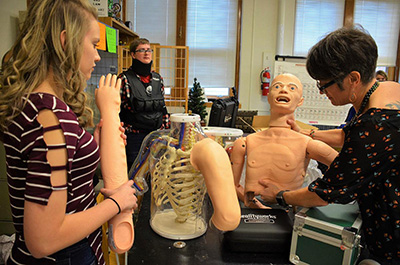CTE Grant Boosts Health Occupations Class

From the Black Hills Pioneer:
A $30,000 South Dakota Career and Technical Education (CTE) Established Program to Stimulate Competitive Research (EPSCoR) grant for health science careers allowed a Lead-Deadwood High School classroom to be filled with boxes bearing a patient simulator, geriatric simulator, and other materials Monday.
“We are thrilled to have been awarded this grant,” said Superintendent Dr. Dan Leikvold.
Dr. Bree Oatman, health sciences occupations/chemistry teacher, announced the receipt of the grant at the Nov. 12 board of education meeting, and the materials arrived at the high school Monday.
“The … grant provides schools with funding to build capacity for STEM (science, math, engineering, and math) related careers,” she said. “I wrote the grant to receive funding to buy sim-patient mannequins and other equipment for simulating IVs, injections, wound care, and catheterizations.”
The grant was awarded in late October, Oatman said, and the company Realityworks donated a geriatric empathy kit and an infant skin/wound care kit, as well, which would allow Oatman to implement a state-of-art curriculum for the a new class.
“We have equipment that is on par with what students would get to use at Western Dakota Tech and other allied health college programs,” she said.
For example, included in the kit’s basic nursing package are 48 hands-on resources like three geriatric nursing manikins, a geriatric skin conditions kit, pressure injury kit, male and female catheter simulators, and more.
The kit also includes 20 hours of course content that addresses geriatric skin conditions, pressure injuries, basic patient care, catheterization and cleaning, introduction to blood pressure, introduction to intramuscular, intradermal subcutaneous injections, and introductions to IV insertion and phlebotomy, among others.
A couple of years ago, Oatman spearheaded the development of a health science careers 1 course at the school, which takes students out into the community to learn about careers at places like Lead-Deadwood Regional Hospital. She wished to expand the course offering to include a hands-on progression called health science careers 2 and bring professionals into the classroom to teach actual nursing techniques.
“I envisioned one mannequin and maybe one IV simulation or catheter simulation for my classroom,” Oatman exclaimed. “But we have three mannequins, five arms, and several different torso models for learning how to do IVs and injections. In addition, there are supplies to teach wound care and an empathy kit for students to experience what it is like to be elderly or to have limited mobility, impaired vision, hearing or sensory/motor abilities. I’m working with Regional Health to identify health care professionals that can come to the school to help teach students the specific clinical skills associated with the simulation equipment.”
Students were highly enthusiastic about familiarizing themselves with the equipment they will be using next semester.
 National Science Foundation RII Track-1 Project:Expanding Research, Education and Innovation in South Dakota
National Science Foundation RII Track-1 Project:Expanding Research, Education and Innovation in South Dakota